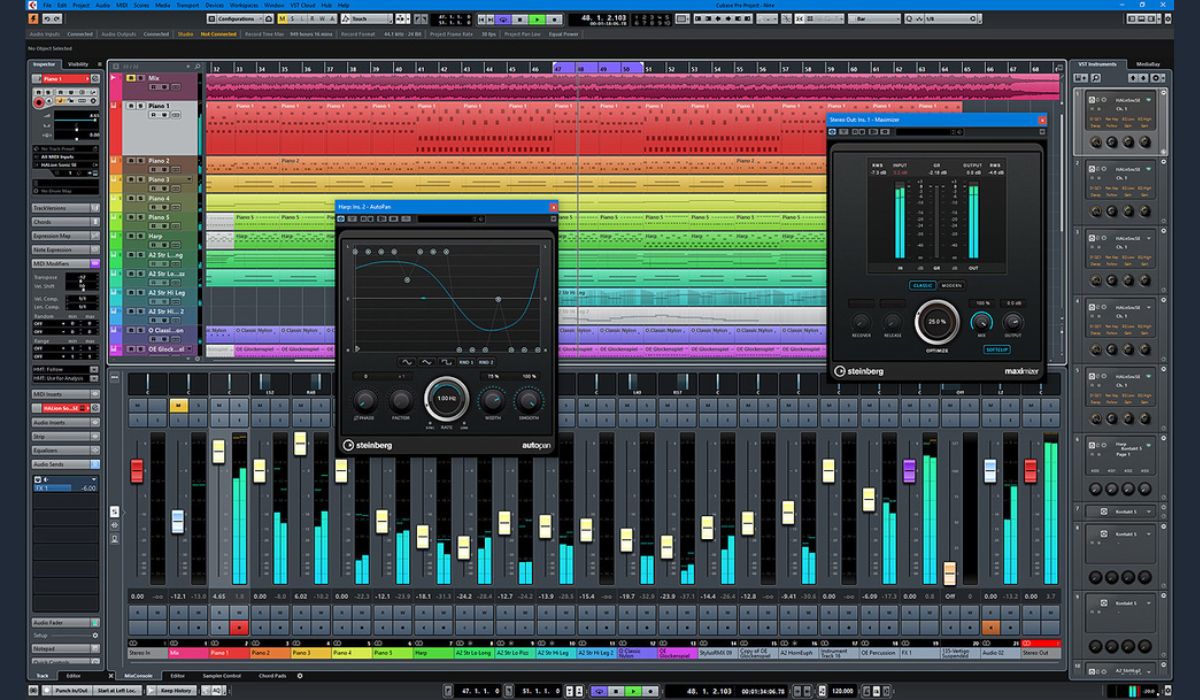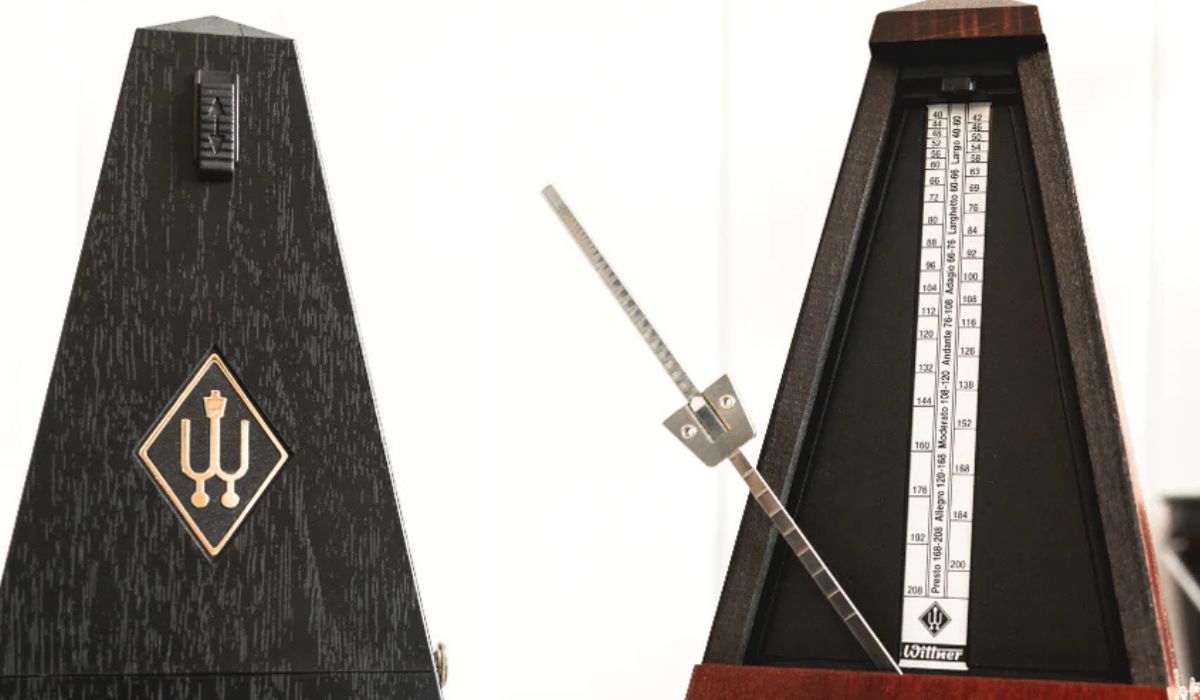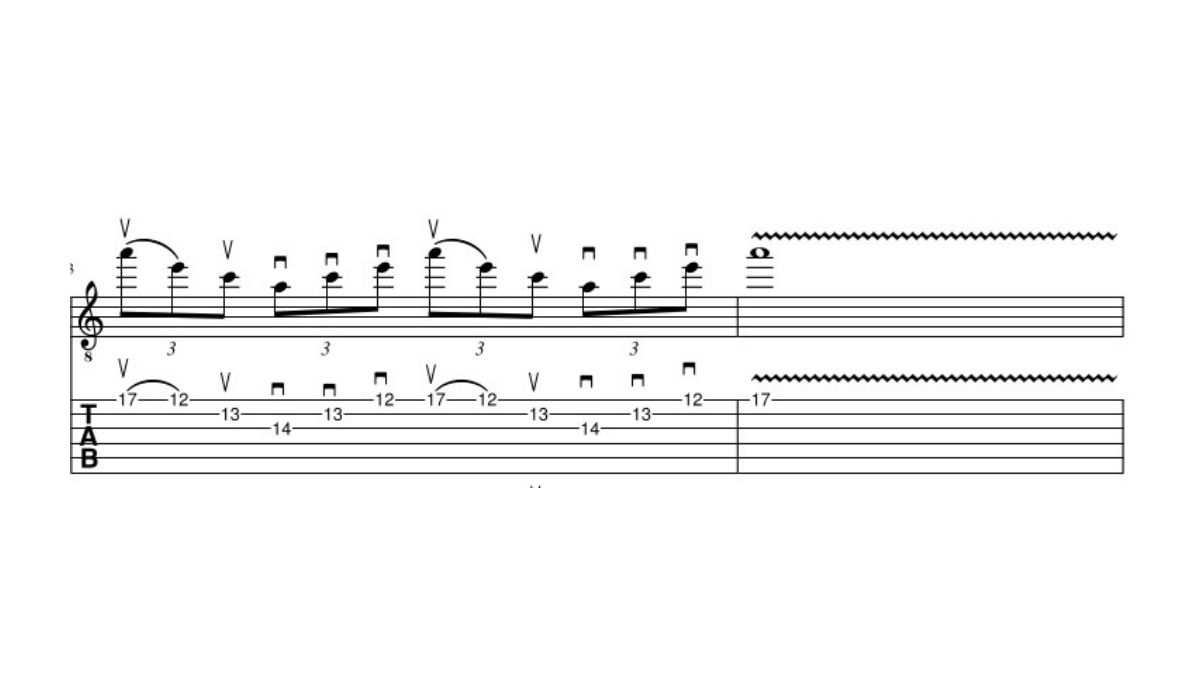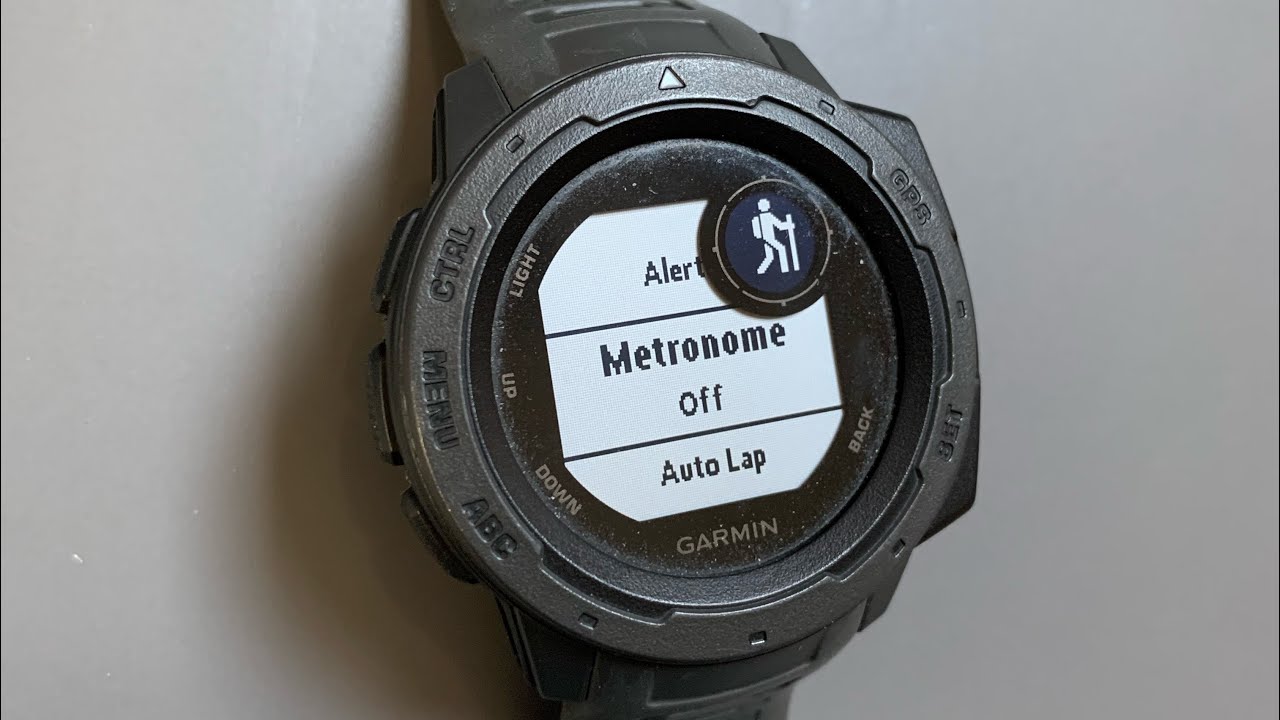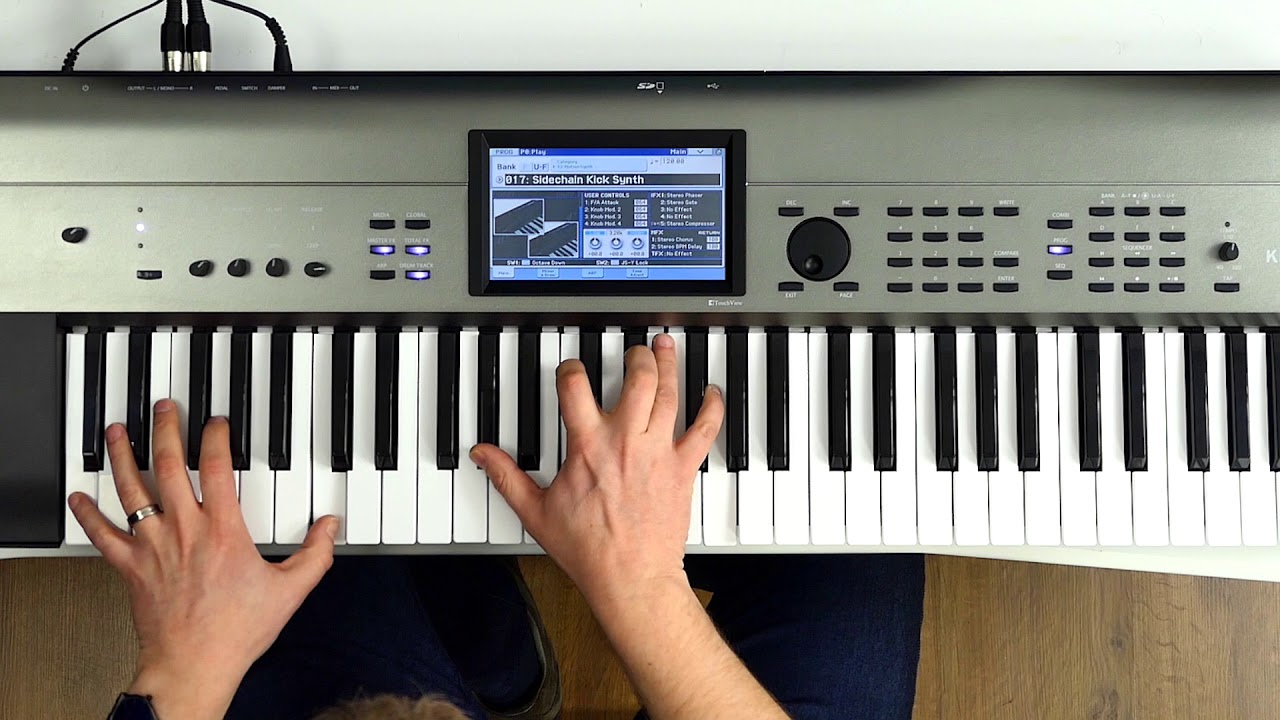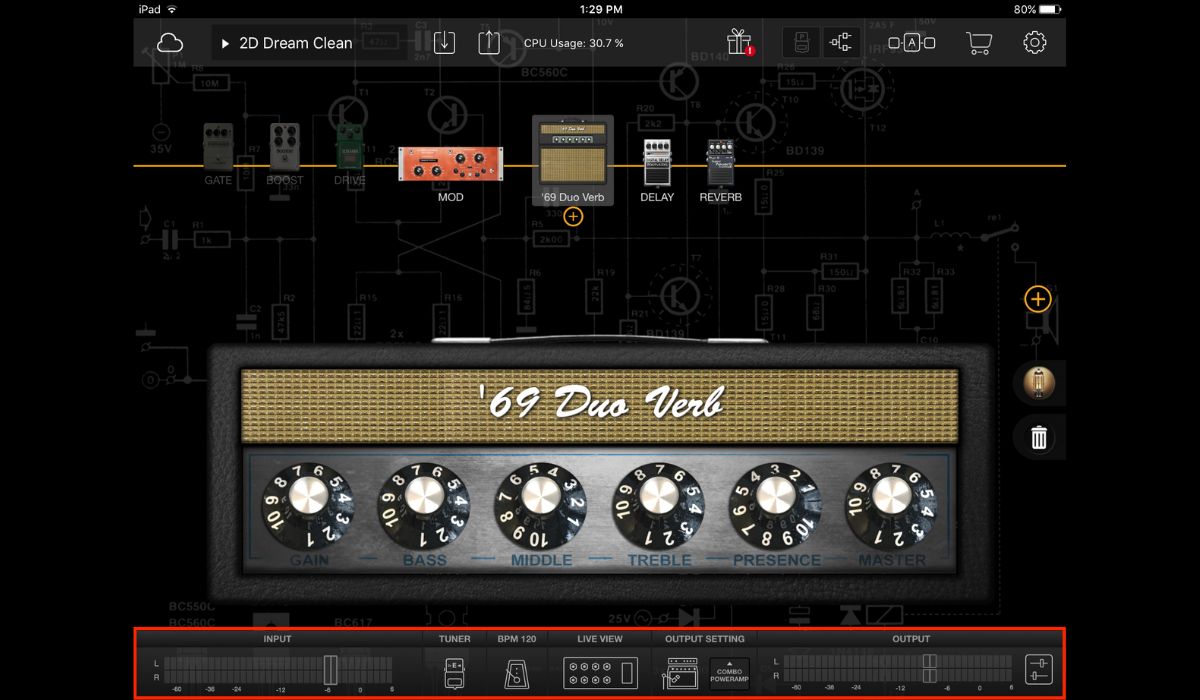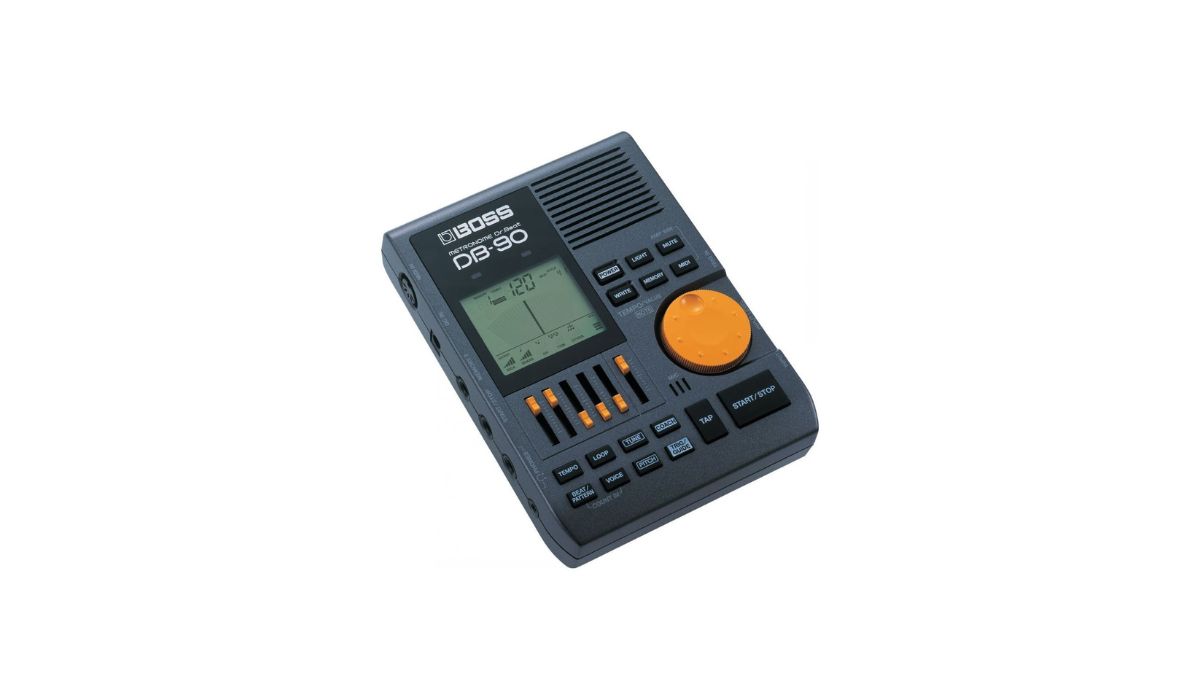Home>Production & Technology>Metronome>How To Practice Using A Metronome
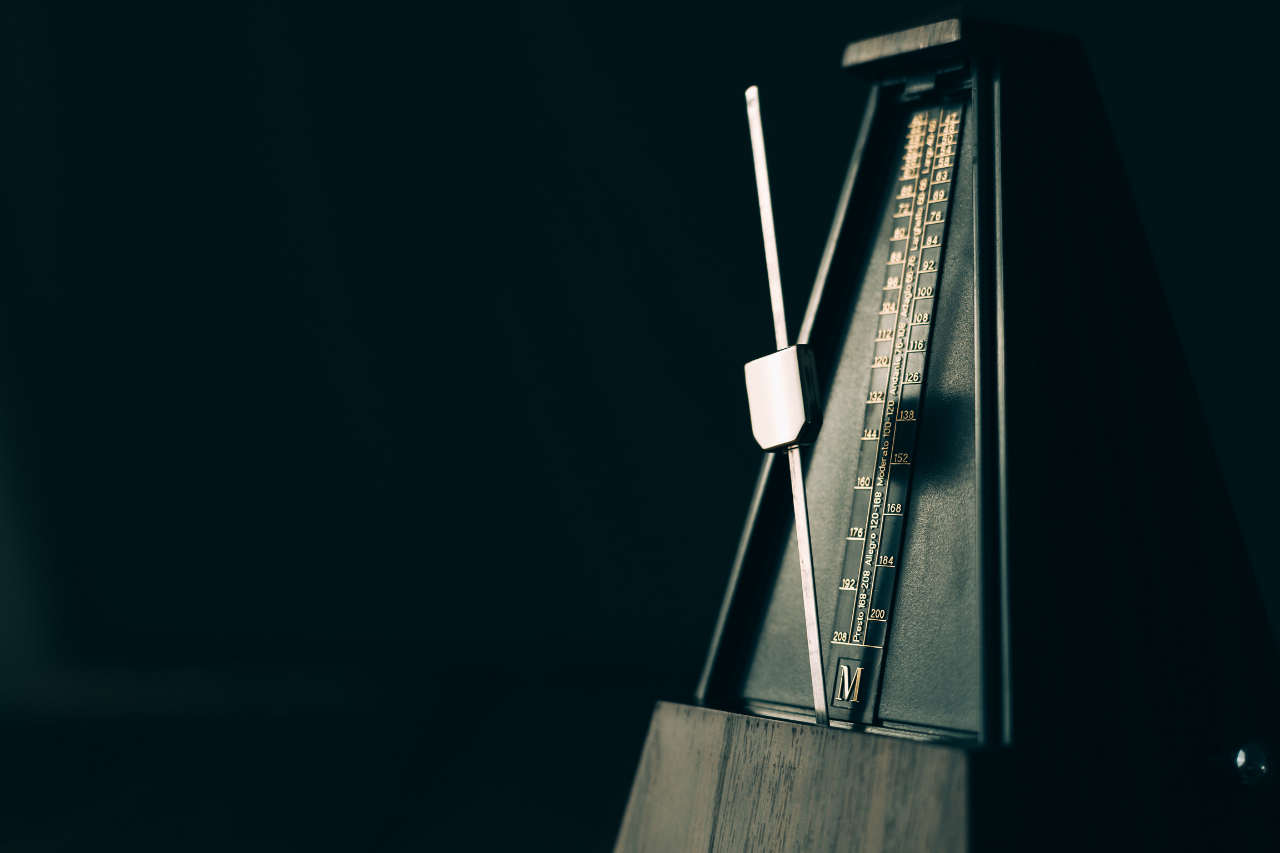

Metronome
How To Practice Using A Metronome
Published: January 14, 2024
Learn how to effectively use a metronome to improve your musical timing and rhythm. Master the art of practicing with a metronome and elevate your musical skills.
(Many of the links in this article redirect to a specific reviewed product. Your purchase of these products through affiliate links helps to generate commission for AudioLover.com, at no extra cost. Learn more)
Table of Contents
- Introduction
- Benefits of Using a Metronome
- Getting Started with a Metronome
- Choosing the Right Metronome
- Understanding Basic Metronome Functions
- Setting the Metronome Tempo
- Incorporating the Metronome into Practice Sessions
- Practical Exercises for Using a Metronome
- Advanced Techniques for Metronome Practice
- Troubleshooting Common Metronome Issues
- Final Thoughts
Introduction
Playing an instrument is a wonderful journey of self-expression and creativity. Whether you are a beginner or an experienced musician, one tool that can greatly enhance your practice sessions is a metronome.
A metronome is a device that produces regular beats at a specific tempo, helping musicians develop a sense of rhythm and timing. It serves as a reliable guide, ensuring that your playing stays on track and that you maintain a steady tempo.
In this article, we will delve into the world of metronomes and explore the various benefits of incorporating them into your practice routine. We will also provide a step-by-step guide on how to get started with a metronome, as well as tips on choosing the right one for your needs.
Using a metronome not only improves your timing and rhythmic accuracy, but it also helps you develop better precision, control, and consistency in your playing. It is an essential tool for musicians of all levels and genres, whether you play the piano, guitar, drums, or any other instrument.
So, whether you’re just starting out or looking to take your musical skills to the next level, let’s dive in and discover how to effectively practice using a metronome.
Benefits of Using a Metronome
Using a metronome in your practice sessions offers a multitude of benefits that can greatly enhance your musical skills. Here are some key advantages of incorporating a metronome into your practice routine:
- Improves Timing and Rhythm: One of the most significant benefits of using a metronome is that it helps improve your timing and rhythm. By practicing with a steady beat, you develop a strong internal sense of timing, which is crucial for playing with precision and accuracy.
- Enhances Musical Expression: While the metronome provides a consistent beat, it also allows room for musical interpretation. By playing with the metronome and experimenting with slight variations in timing and dynamics, you can bring more musical expression to your playing.
- Builds Speed and Accuracy: Playing with a metronome is an effective way to build speed and accuracy in your playing. By gradually increasing the tempo and challenging yourself to keep up with the beat, you can develop greater technical proficiency and dexterity on your instrument.
- Fosters Discipline and Focus: Practicing with a metronome requires discipline and focus. It helps you stay committed to a consistent practice routine and trains your mind to concentrate on maintaining a steady tempo. This discipline and focus can transfer into other areas of your musical development.
- Develops a Strong Internal Pulse: Playing with a metronome trains your inner sense of pulse and rhythm. Over time, you will develop a natural feeling for the beat, allowing you to stay in time even without the assistance of a metronome or other external timing references.
- Prepares for Playing with Others: When you practice with a metronome, you develop the ability to play in sync with other musicians. This skill is invaluable when playing in bands, orchestras, or any collaborative musical setting.
By incorporating a metronome into your practice sessions, you can unlock your full musical potential and become a more well-rounded and accomplished musician. The benefits extend beyond just playing accurately – they also contribute to your overall musicality, expression, and versatility.
Getting Started with a Metronome
Now that you understand the benefits of using a metronome, let’s explore how to get started with this invaluable practice tool.
1. Select the Right Metronome: There are various types of metronomes available, including traditional mechanical metronomes, digital metronomes, and metronome apps. Choose one that suits your preferences and budget. Digital metronomes and metronome apps are popular choices due to their versatility and convenience.
2. Familiarize Yourself with Basic Functions: Once you have your metronome, take some time to understand its basic functions. Learn how to adjust the tempo, time signature, and volume. Familiarize yourself with any additional features that may be available, such as different sounds or subdivisions.
3. Start with a Slow Tempo: Begin your practice sessions with a slow tempo. This allows you to focus on playing accurately and maintaining a steady beat. As you become more comfortable, gradually increase the tempo to challenge yourself.
4. Choose Appropriate Time Signatures: Determine the time signature of the piece or exercise you are practicing. Set the metronome to match the time signature, ensuring that the beats align with the music’s rhythmic structure. Common time signatures include 4/4, 3/4, and 6/8, among others.
5. Start with Simple Exercises: Begin by practicing simple exercises or scales with the metronome. Focus on playing each note precisely in time with the metronome’s beat. This helps develop your sense of timing and coordination.
6. Challenge Yourself with Complex Patterns: Once you feel comfortable with basic exercises, gradually introduce more complex patterns. This could involve playing syncopated rhythms, different subdivisions, or intricate melodic lines. The metronome will assist you in maintaining a consistent beat while tackling these challenging musical elements.
7. Experiment with Dynamics: The metronome provides a steady beat, but it doesn’t restrict your dynamics. Experiment with playing softer or louder parts while staying in time with the metronome. This helps build control and expression in your playing.
8. Record and Analyze: Use a recording device or software to record your practice sessions with the metronome. Listen back to identify areas that need improvement, such as moments where you rushed or lagged behind the beat. This feedback helps you refine your timing and overall performance.
Remember to approach your practice sessions with patience and consistency. Practice regularly and gradually increase the difficulty level as you progress. With time and dedication, you will reap the rewards of using a metronome in your musical journey.
Choosing the Right Metronome
When it comes to selecting the right metronome for your needs, there are a few factors to consider. Here are some crucial aspects to keep in mind while choosing the perfect metronome:
- Type of Metronome: Decide whether you prefer a traditional mechanical metronome or a digital one. Mechanical metronomes offer a nostalgic appeal with their swinging pendulums, while digital metronomes provide more features and versatility.
- Functions and Features: Look for essential functions such as tempo adjustment, time signature options, and volume control. Additionally, consider additional features like subdivisions, accent patterns, and preset rhythms to diversify your practice sessions.
- Portability: If you plan on practicing on the go, choose a metronome that is compact and lightweight. There are many metronome apps available for smartphones and tablets that provide excellent portability.
- Visual and Audible Indications: Check if the metronome has clear visual indicators such as flashing lights or a digital display, as well as audible cues such as clicks or beeps. These indicators will help you stay synchronized with the beat effectively.
- Power Options: Consider the power source of the metronome. Traditional mechanical metronomes require winding, while digital metronomes can be powered by batteries or electricity. Choose a power source that suits your preference and convenience.
- Price and Durability: Set a budget for your metronome purchase. Consider investing in a durable metronome that withstands regular use. While there are budget-friendly options available, quality and durability should not be compromised.
- User-Friendly Interface: Ensure that the metronome’s controls and settings are intuitive and easy to navigate. A user-friendly interface will save you time and frustration when making adjustments during your practice sessions.
- Reviews and Recommendations: Read reviews and seek recommendations from experienced musicians or music teachers. Their insights and experiences can guide you towards reliable metronome options that are well-suited for your instrument and genre.
Ultimately, the perfect metronome is one that suits your preferences, needs, and budget. It should have the necessary functions to enhance your practice sessions and assist in your musical development. Take your time to research and compare different metronomes before making a decision. Remember, the right metronome can significantly impact the quality of your practice sessions and improve your overall musicianship.
Understanding Basic Metronome Functions
Before diving into using a metronome for your practice sessions, it is essential to understand the basic functions and features that most metronomes offer. Here are the fundamental elements to familiarize yourself with:
- Tempo Adjustment: The tempo controls allow you to set the speed or beats per minute (BPM) of the metronome. This feature determines how fast or slow the beats will be. You can adjust the tempo to match the desired speed for your practice piece or exercise.
- Time Signature Selection: The time signature setting allows you to choose the appropriate rhythm structure for your practice. Common time signatures include 4/4 (common time), 3/4 (waltz), and 6/8 (compound time). Selecting the correct time signature ensures that the metronome’s beats align with the music’s rhythmic structure.
- Volume Control: The volume control allows you to adjust the loudness of the metronome clicks or beeps. You can set the volume to a comfortable level that allows you to hear the metronome clearly without overwhelming your playing.
- Subdivisions: Some metronomes offer the option to subdivide the beats into smaller note values. This feature is particularly helpful when practicing complex rhythms. For example, you can set the metronome to provide beats for eighth notes or sixteenth notes, enabling you to practice intricate patterns with precision.
- Accent Patterns: Certain metronomes have built-in accent patterns that emphasize specific beats within a measure. This feature is useful for practicing syncopated rhythms or focusing on specific beats within a complex passage.
- Preset Rhythms and Styles: Advanced metronomes may include preset rhythms and styles to add variety to your practice routine. These presets simulate different musical genres or grooves, providing a more engaging and dynamic metronome experience.
- Tap Tempo: Some metronomes have a “tap tempo” function that allows you to set the desired tempo by tapping a button according to the desired rhythm. This feature is helpful when you need to quickly match the tempo of a song or when playing with other musicians.
Each metronome model may have its unique way of accessing and adjusting these functions. Familiarize yourself with the user manual or instructions specific to your metronome to fully understand how to utilize these features effectively for your practice sessions.
By grasping the basic functions of a metronome, you will have the necessary tools to enhance your timing, rhythm, and overall musicality. Experiment with different settings and explore the various functions to find what works best for you and your musical goals. Whether you are a beginner or a seasoned musician, understanding these functions will set you on the path to productive and efficient practice with a metronome.
Setting the Metronome Tempo
Setting the tempo on a metronome is a crucial step in using this tool effectively for your practice sessions. The tempo determines the speed at which the metronome produces beats, and it is essential to match the tempo to the desired speed of the music you are playing or practicing. Here’s how you can set the metronome tempo:
- Identify the Desired BPM: Determine the BPM (beats per minute) you want to set on the metronome. The BPM represents the number of beats the metronome will produce in one minute. You can find the recommended BPM for a specific musical piece, or you can start with a comfortable tempo and gradually increase it as you become more proficient.
- Adjust the Metronome Dial or Buttons: Most metronomes have a dial or buttons that allow you to adjust the tempo. Locate the tempo adjustment feature on your metronome. If you have a digital metronome, it may have arrow buttons or a numerical keypad to enter the desired BPM directly.
- Use the Tap Tempo Feature (if available): Some metronomes have a tap tempo feature that allows you to set the tempo by tapping a button rhythmically. This feature is handy when you need to quickly match the tempo of a song or when playing with other musicians who may not have a metronome.
- Start with a Slow Tempo: If you are unsure about the appropriate tempo for a particular piece, it’s generally a good idea to start with a slower tempo. Beginning with a slow tempo allows you to focus on accuracy and gradually build speed and proficiency.
- Gradually Increase the Tempo: As you become more comfortable playing at a certain tempo, challenge yourself by gradually increasing the metronome’s speed. This helps develop your technical skills and pushes you to play with greater precision and control.
- Find a Tempo that Works for You: It’s important to remember that the tempo you choose should be comfortable for you to play while maintaining both technical accuracy and musical expression. Experiment with different tempos to find the optimal speed that suits your playing style and musical goals.
Setting the metronome tempo is a process of trial and error. It requires patience and flexibility to find the right tempo that allows you to play with confidence and musicality. Don’t be afraid to adjust the metronome tempo as needed throughout your practice sessions to accommodate different musical passages or sections with varying speeds.
Remember, the primary purpose of the metronome is to help you maintain a consistent beat and develop a strong sense of timing. Utilize the metronome as a tool to challenge yourself, improve your performance, and cultivate your musical skills with precision and accuracy.
Incorporating the Metronome into Practice Sessions
The metronome can be a powerful tool to enhance your practice sessions and elevate your musical abilities. Here are some effective ways to incorporate the metronome into your practice routine:
- Warm-up Exercises: Begin your practice session with simple warm-up exercises like scales or arpeggios. Set the metronome to a slow tempo and play along with the beats, focusing on precise timing and consistent rhythm.
- Play Along with Songs: Choose your favorite songs or pieces and play along with the metronome. Set the metronome to match the tempo of the song, ensuring that your playing stays in sync with the original recording.
- Focus on Technical Exercises: Use the metronome to practice technical exercises, such as finger exercises or challenging passages in a piece. Start with a comfortable tempo and gradually increase the speed, keeping your playing clean and accurate.
- Practice Difficult Rhythms: If you encounter difficult rhythms in your music, use the metronome to tackle them. Set the metronome to subdivide the beats and practice slowly, gradually increasing the tempo as you become more comfortable.
- Progressive Tempo Increase: For pieces or sections that require speed, set the metronome to a slow tempo at first. Practice the section accurately and gradually increase the tempo in small increments until you reach the desired speed.
- Dynamic Control: Experiment with dynamics while using the metronome. Practice playing softer or louder parts while still maintaining a steady beat. This improves your control and adds expressive nuances to your playing.
- Off-Beat Exercises: Challenge your sense of timing by practicing off-beat exercises. Set the metronome to play on the second or third beat of the measure, forcing you to maintain a consistent rhythm, even without the expected downbeat.
- Polishing Performance Pieces: Use the metronome to refine your performance pieces. Set the metronome to the desired tempo and play through the piece, focusing on precise timing and maintaining a steady rhythm throughout.
- Practice with Accents: Utilize the metronome’s accent pattern feature to emphasize specific beats or note groupings within a measure. This helps develop your rhythmic precision and control.
While incorporating the metronome into your practice sessions, remember to maintain a balance between following the metronome and expressing your musicality. The metronome is a helpful guide, but it should not restrict your interpretation or musical expression. Use it as a tool to build a solid foundation of rhythm and timing, allowing you to confidently express yourself on your instrument.
Regularly practicing with the metronome will strengthen your sense of timing, improve your accuracy, and enhance your overall musicality. Over time, you will notice significant progress as you internalize the beat and develop a more solid and confident rhythmic foundation.
Practical Exercises for Using a Metronome
There are numerous practical exercises you can incorporate into your practice sessions to make the most of using a metronome. These exercises will help you develop a strong sense of timing, improve your rhythmic accuracy, and enhance your overall musicality. Here are some effective exercises to try:
- Scales: Practice scales by setting the metronome to a slow tempo. Play each note precisely in sync with the metronome’s beat, focusing on evenness and clarity in your execution.
- Accent Variations: Experiment with different accent patterns while playing scales or exercises. Set the metronome to accent every third note, for example, to challenge your rhythmic control and precision.
- Dotted Rhythms: Set the metronome to a slow tempo and practice playing dotted rhythms. This exercise helps improve your timing and control over syncopated patterns.
- Subdivisions: Choose a specific subdivision, such as eighth notes or sixteenth notes, and practice playing scales or exercises using that subdivision. Set the metronome to provide beats for the selected subdivision, helping you develop a strong internal pulse.
- Rhythm Repetition: Set the metronome to a comfortable tempo and practice repeating rhythmic patterns. Start with simple patterns and gradually increase the complexity. This exercise improves your rhythmic accuracy and coordination.
- Tempo Graduation: Choose a challenging passage from a piece or an exercise and start at a slow tempo. Gradually increase the metronome tempo in small increments, ensuring that you can maintain accuracy and control at each speed. This exercise helps build speed and precision.
- Syncopation and Off-Beat: Practice playing syncopated rhythms or off-beat patterns with the metronome. Set the metronome to accent the off-beat notes, helping you develop a stronger sense of rhythm and improve your timing accuracy.
- Dynamic Control: Use the metronome to develop dynamic control by practicing passages with various volume levels. Experiment with crescendos, decrescendos, and playing certain sections softly while maintaining a steady beat.
- Polyrhythms: Set the metronome to a specific time signature while practicing a different time signature or rhythmic pattern. This exercise challenges your ability to count and play multiple rhythms simultaneously.
- Phrase Endings: Set the metronome to play a few bars and then to pause for a bar. Practice ending phrases precisely on cue when the metronome starts again. This exercise helps improve your sense of timing and phrasing.
When practicing these exercises, start with a slower tempo and gradually increase the speed as you become more comfortable. Pay attention to your posture, technique, and the sound quality of your playing while maintaining a steady rhythm with the metronome.
Remember, the goal of these exercises is not only to improve your technical skills but also to develop your musicality and expressiveness. Use the metronome as a tool to create a solid rhythmic foundation that you can build upon with creativity and musical interpretation.
Regularly incorporating these practical exercises into your practice routine will help you develop a keen sense of timing, strengthen your rhythmic accuracy, and elevate your overall musical performance.
Advanced Techniques for Metronome Practice
Once you have mastered the basics of using a metronome and incorporated it into your regular practice routine, you can explore more advanced techniques to further enhance your musical skills. These techniques will challenge your timing, coordination, and musicality. Here are some advanced techniques for metronome practice:
- Polyrhythms and Cross-Rhythms: Set the metronome to a specific time signature and practice playing different rhythms against it. For example, you can play triplets in one hand while the metronome maintains a steady beat. This exercise strengthens your ability to synchronize multiple rhythms simultaneously.
- Change Time Signatures: Choose a piece of music with irregular time signatures and practice playing it with the metronome. Adjust the metronome’s time signature to match the piece and train yourself to navigate through changes in meter while staying in time.
- Advanced Subdivisions: Challenge yourself by setting the metronome to a higher subdivision, such as triplets or sixteenth-note triplets. Play scales, exercises, or musical passages using these subdivisions to improve your rhythmic precision and control.
- Tempo Modulation: Practice gradually increasing or decreasing the tempo within a piece or exercise. Start at a slow tempo and progressively speed up or slow down the metronome, allowing yourself to adapt to the changing tempo smoothly and accurately.
- Offbeat Accents: Experiment with offbeat accents by setting the metronome to accent the offbeat notes. This exercise challenges your sense of timing and helps you develop a strong internal pulse even when the accent falls on unexpected beats.
- Metric Modulation: Explore metric modulation by changing the underlying pulse of a piece or exercise. Set the metronome to a new tempo that represents a different rhythmic subdivision or time signature, and practice transitioning smoothly between the two pulses.
- Syncopated Patterns: Set the metronome to a simple, steady beat and practice playing syncopated patterns within that framework. This exercise improves your ability to play rhythms that emphasize offbeats and creates rhythmic interest in your playing.
- Improvise with the Metronome: Use the metronome as a foundation for improvisation. Set a steady tempo and create melodic or rhythmic variations while staying in time with the metronome’s beat. This exercise enhances your ability to improvise within a structured rhythmic framework.
- Polymeter and Polyrhythm: Set the metronome to one time signature and play in a different time signature simultaneously. This exercise challenges your coordination and rhythmic awareness by requiring simultaneous playing in different meters.
- Gradual Tempo Changes: Practice gradually increasing or decreasing the tempo in small increments while playing a piece or exercise. This technique builds flexibility and adaptability in maintaining a steady tempo when faced with tempo fluctuations within a musical context.
Remember to approach these advanced techniques gradually and practice at a comfortable tempo before attempting faster or more complex variations. These techniques require concentration, precision, and musical sensitivity. They will push your boundaries and help you develop a deeper understanding of rhythm and timing.
By incorporating these advanced techniques into your metronome practice, you will expand your rhythmic capabilities and develop a heightened sense of musicality. It’s essential to balance technical proficiency with expressive playing, allowing the metronome to guide you while still expressing your own unique musical interpretation.
Troubleshooting Common Metronome Issues
While using a metronome can greatly benefit your practice sessions, it’s not uncommon to encounter a few issues along the way. Here are some common metronome problems and solutions to troubleshoot them:
- Metronome Not Keeping Steady Time: If your metronome is not maintaining a consistent beat, check the battery or power source. Low battery power can cause irregularity in the beat. Replace or recharge the battery as necessary.
- Difficulty Staying in Sync with the Metronome: If you find it challenging to stay in sync with the metronome, try practicing at a slower tempo first. Gradually increase the tempo as you become more comfortable. Use the metronome’s accent feature or subdivisions to strengthen your inner sense of timing.
- Feeling Restricted by the Metronome: While the metronome is an essential practice tool, it’s important to balance it with expressive playing. Experiment with playing ahead or behind the beat intentionally to develop a sense of musicality. Remember, the metronome is a guide, not a rigid constraint.
- Difficulty with Complex Rhythms: If you’re struggling with complex rhythms, slow down the tempo and practice at a comfortable speed. Break down the rhythm into smaller parts and work on each segment individually before combining them. Gradually increase the tempo as your accuracy and control improve.
- Inability to Maintain a Steady Tempo: If you have difficulty maintaining a steady tempo, practice with the metronome regularly. Start with simple exercises and gradually increase the complexity. Focus on internalizing the beat and develop a strong internal pulse. Over time, your ability to maintain a steady tempo will improve.
- Audio Output Issues: If you’re experiencing audio output issues, check the connection of your metronome if it’s an external device. For digital metronomes or metronome apps, ensure that the volume is turned up and no external factors are blocking the sound. Adjust the volume control or switch to a different sound option if available.
- Metronome Distraction: If you find the sound of the metronome distracting, experiment with using a different sound or adjusting the volume. Some metronomes offer a silent or visual mode where you can rely on visual indicators instead of audible cues.
- Lack of Motivation or Boredom: If you become bored or unmotivated with the metronome, add variety to your practice routine. Incorporate different musical styles, play along with backing tracks, or engage in creative improvisation with the metronome as a foundation. Find ways to make practice sessions stimulating and enjoyable.
Remember, patience and persistence are key when troubleshooting metronome issues. It may take time and experimentation to find the right solutions that work for you. Continuously assess your practice sessions and make adjustments as needed to ensure that the metronome serves as a helpful tool in your musical development.
Final Thoughts
Using a metronome can greatly benefit musicians of all levels and disciplines. It is a valuable tool that enhances your timing, rhythm, precision, and overall musicality. By incorporating the metronome into your practice sessions, you develop a strong foundation of timing and build the necessary skills to play with accuracy and confidence.
As you explore the world of metronome practice, remember to strike a balance between technical precision and musical expression. The metronome is a guide, not a strict taskmaster. Use it as a tool to bring structure and discipline to your practice, while still allowing room for your personal interpretation and creativity.
Be patient with yourself as you work with the metronome. It may take time to adjust to the consistent beat and develop a steady tempo. Start with slow tempos and gradually build up speed as your proficiency increases. Celebrate small victories along the way and recognize that progress is made through consistent practice and dedication.
Keep your practice sessions engaging by incorporating a variety of exercises and techniques. Experiment with different time signatures, subdivisions, accents, and rhythmic patterns. Explore advanced techniques to challenge yourself and expand your rhythmic capabilities. Remember to introduce musicality into your practice, allowing the metronome to guide your timing while expressing your unique interpretation and emotions as a musician.
Lastly, embrace the metronome as a valuable companion on your musical journey. It is a trusted ally that will support and elevate your playing. Regular and intentional practice with the metronome will strengthen your sense of timing, improve your rhythmic accuracy, and ultimately enhance your overall performance as a musician.
So, whether you are a beginner taking your first steps or an experienced musician seeking to polish your skills, the metronome is a powerful tool that will accompany you throughout your musical development. Embrace it, practice with it, and let it guide you to new heights of musical excellence.

